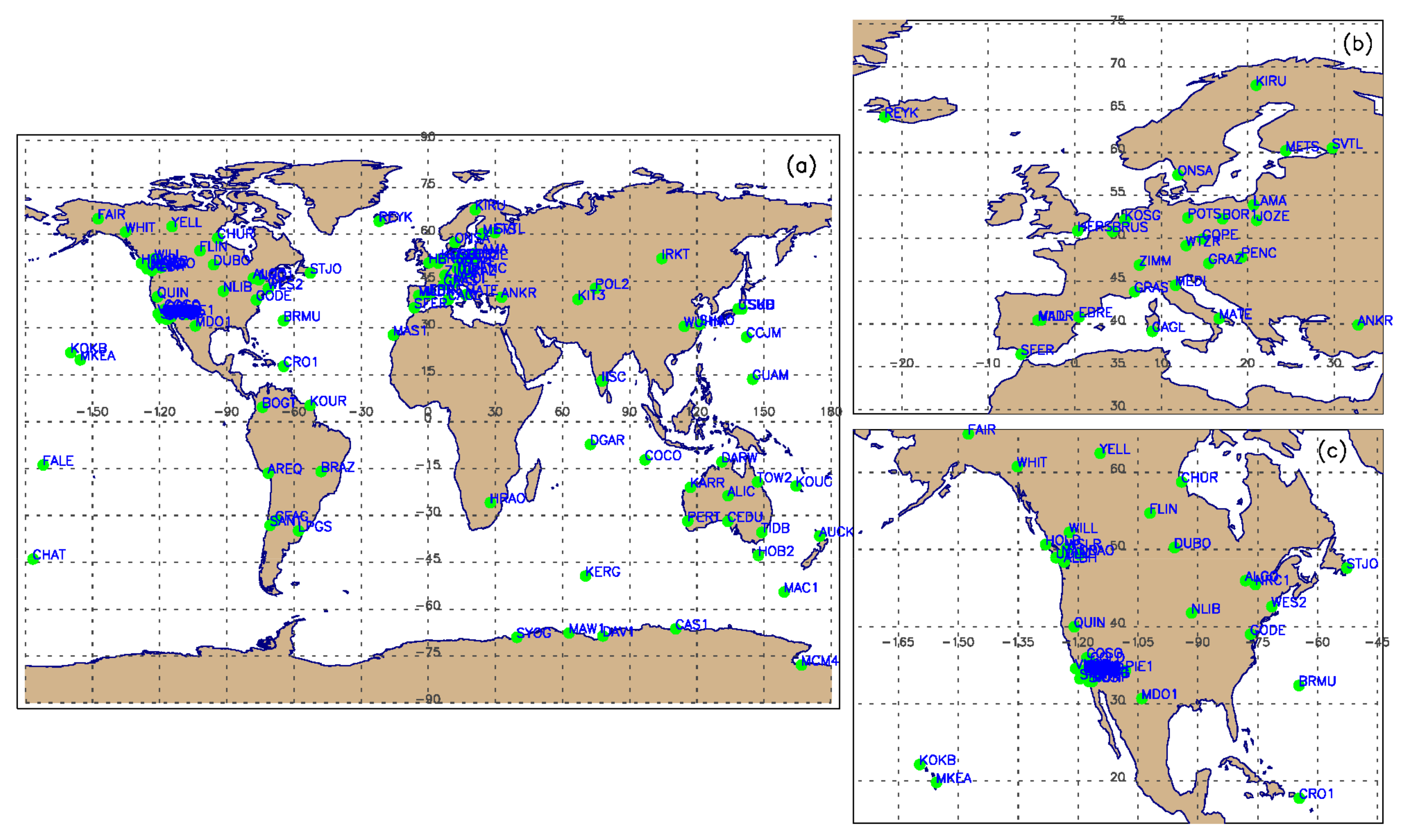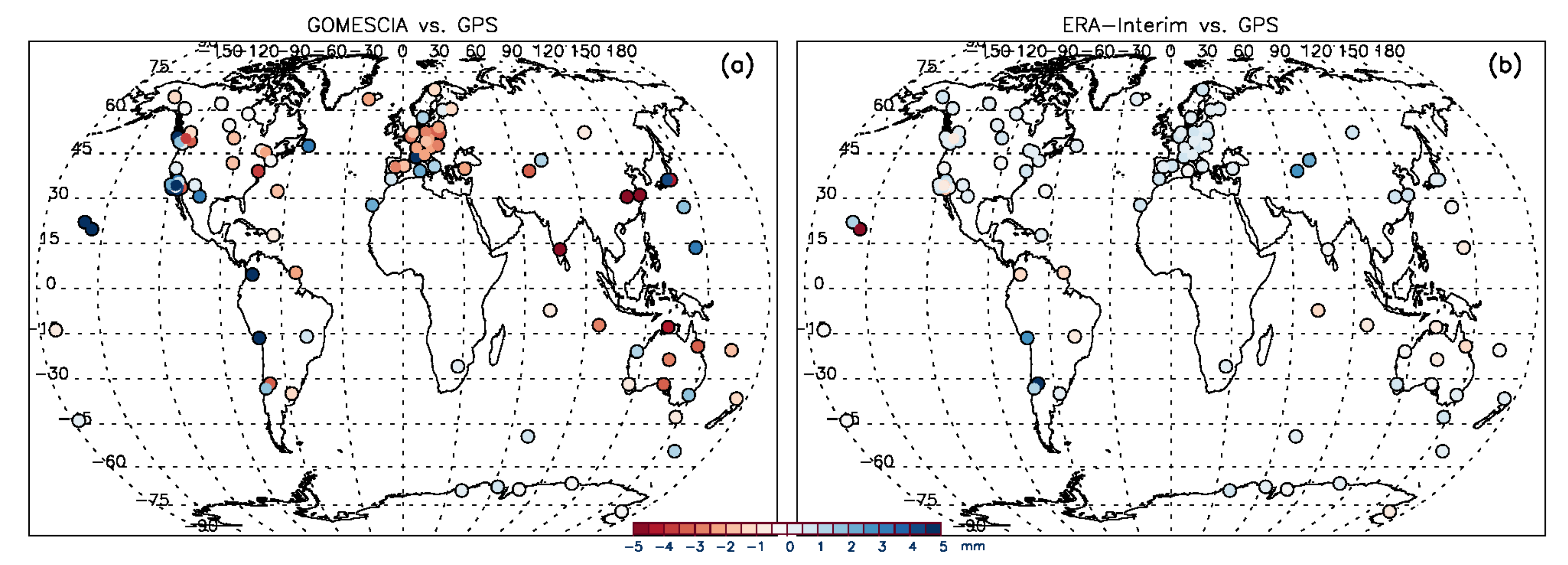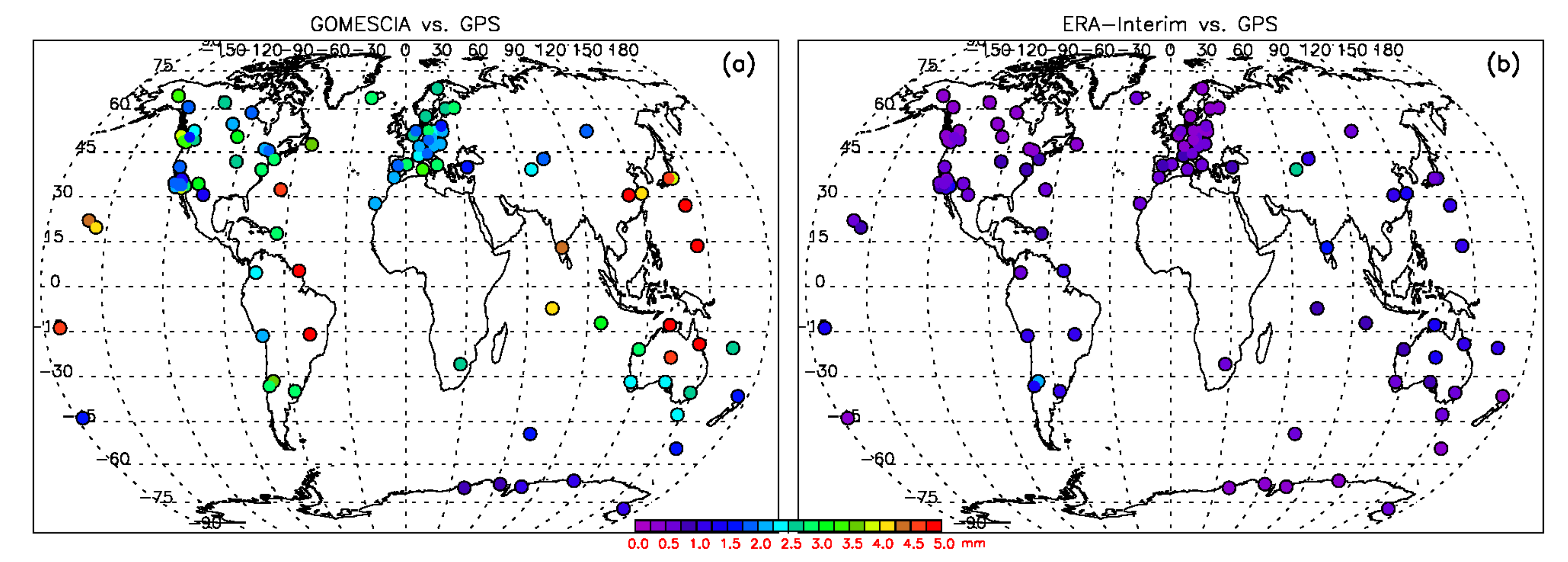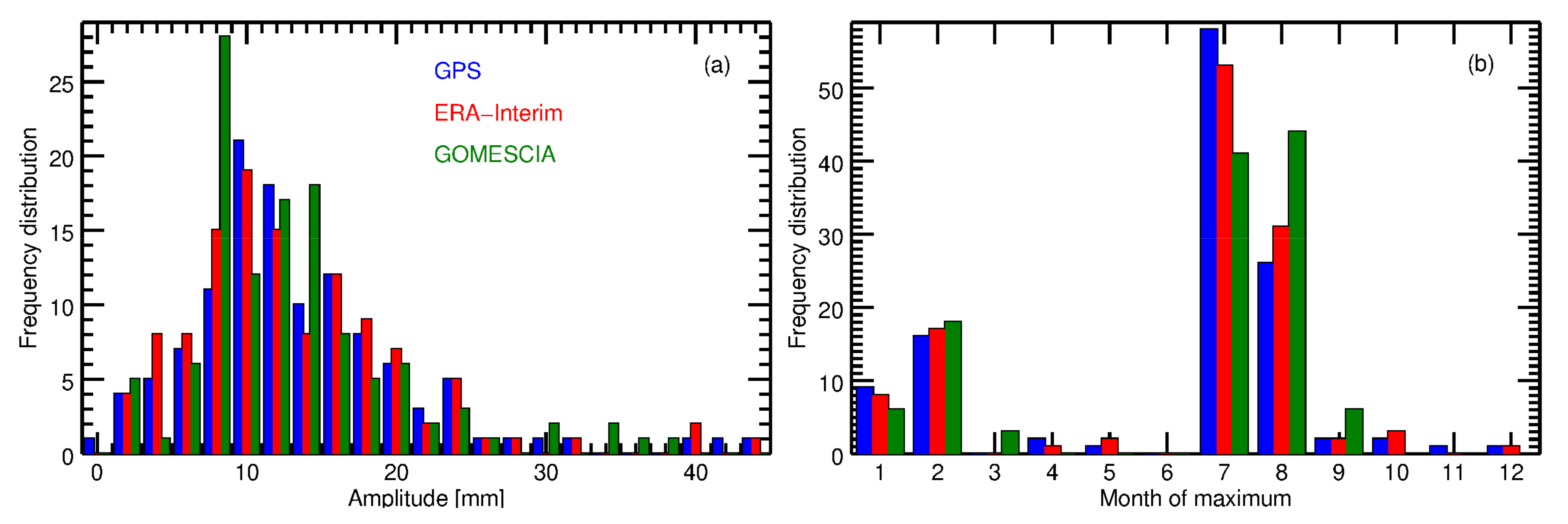Global Spatiotemporal Variability of Integrated Water Vapor Derived from GPS, GOME/SCIAMACHY and ERA-Interim: Annual Cycle, Frequency Distribution and Linear Trends
Abstract
:1. Introduction
2. Datasets and Methodology
2.1. GPS
2.2. GOME/SCIAMACHY/GOME-2
2.3. ERA-Interim Reanalysis Model
3. Results
3.1. Dataset Comparison
3.2. Seasonal Behavior
3.3. Frequency Distribution
3.4. Linear Trends
4. Discussion
Supplementary Materials
Author Contributions
Funding
Institutional Review Board Statement
Informed Consent Statement
Data Availability Statement
Acknowledgments
Conflicts of Interest
Appendix A
| Mean Difference (mm) | Mean Abs. Difference (mm) | SD (mm) | R² | Trend (mm dec−1) | Abs Trend (mm dec−1) | |
|---|---|---|---|---|---|---|
| (a) | Tm = ERA, Ps = ERA: influence IGS data | |||||
| IWV = ERA | −0.313 ± 1.011 | 0.669 ± 0.818 | 3.807 | 0.962 | −0.102 ± 0.457 | 0.322 ± 0.338 |
| (b) | Tm = ERA, Ps = ERA: influence Ps | |||||
| Tm = ERA, and Ps =SYNOP * | −0.200 ± 0.614 | 0.301 ± 0.570 | 7.575 | 0.961 | −0.290 ± 0.752 | 0.353 ± 0.724 |
| (c) | Tm = Bevis and Ts = ERA, Ps = SYNOP: influence Ts | |||||
| Tm = Bevis and Ts = SYNOP, Ps = SYNOP * | 0.009 ± 0.025 | 0.020 ± 0.017 | 0.029 | 1.000 | 0.013 ± 0.244 - | 0.107 ± 0.219 |
| (d) | Tm = ERA, Ps = ERA: influence Bevis et al., regression (Tm) | |||||
| Tm = Bevis and Ts = ERA, Ps = ERA | 0.044 ± 0.092 | 0.069 ± 0.075 | 0.025 | 1.000 | −0.004 ± 0.031 - | 0.018 ± 0.025 |
| (e) | Tm = ERA, Ps = SYNOP: influence Ts and Bevis et al., regression | |||||
| Tm = Bevis and Ts = SYNOP, Ps = SYNOP * | 0.026 ± 0.071 | 0.051 ± 0.055 | 0.052 | 1.000 | 0.001 ± 0.248 | 0.110 ± 0.221 |
| (f) | Tm = ERA, Ps = ERA: influence reanalysis dataset | |||||
| Tm = NCEP, and Ps = NCEP | −0.034 ± 0.286 | 0.168 ± 0.233 | 0.154 | 0.995 | −0.015 ± 0.144 | 0.083 ± 0.118 |
| (g) | Tm = ERA, Ps = ERA: observational vs. reanalysis dataset | |||||
| Tm = Bevis and Ts = SYNOP, Ps = SYNOP * | −0.073 ± 0.403 | 0.223 ± 0.342 | 4.705 | 0.971 | −0.210 ± 0.667 | 0.259 ± 0.649 |
| Mean Difference (hPa or K) | Mean Abs. Difference (hPa or K) | SD (hPa or K) | R² | Trend (hPa dec−1 or K dec−1) | Abs Trend (hPa dec−1 or K dec−1) | |
|---|---|---|---|---|---|---|
| (a) | Ps = ERA | |||||
| Ps =NCEP | −0.179 ± 0.788 | 0.447 ± 0.673 | 1.241 | 0.974 | 0.083 ± 0.389 | 0.214 ± 0.335 |
| (b) | Ps = ERA | |||||
| Ps =SYNOP * | 0.031 ± 0.611 | 0.357 ± 0.494 | 0.786 | 0.989 | 0.052 ± 0.401 | 0.277 ± 0.292 |
| (c) | Tm = Bevis and Ts = ERA | |||||
| Tm = Bevis and Ts = SYNOP * | 0.267 ± 0.622 | 0.503 ± 0.447 | 2.878 | 0.979 | 0.197 ± 0.879 | 0.502 ± 0.744 |
| (d) | Tm = ERA | |||||
| Tm = Bevis and Ts = ERA | 0.508 ± 1.583 | 1.235 ± 1.108 | 8.099 | 0.804 | 0.101 ± 0.213 | 0.188 ± 0.140 |
| (e) | Tm = ERA | |||||
| Tm = NCEP | −1.236 ± 0.645 | 1.280 ± 0.552 | 8.678 | 0.926 | 0.080 ± 0.257 | 0.169 ± 0.209 |
References
- Held, I.M.; Soden, B.J. Robust Responses of the Hydrological Cycle to Global Warming. J. Clim. 2006, 19, 5686–5699. [Google Scholar] [CrossRef]
- Trenberth, K.E.; Fasullo, J.; Smith, L. Trends and variability in column-integrated atmospheric water vapor. Clim. Dyn. 2005, 24, 741–758. [Google Scholar] [CrossRef]
- Wentz, F.J.; Ricciardulli, L.; Hilburn, K.; Mears, C. How much more rain will global.warming bring? Science 2007, 317, 233–235. [Google Scholar] [CrossRef]
- Mears, C.A.; Santer, B.D.; Wentz, F.J.; Taylor, K.E.; Wehner, M.F. Relationship between temperature and precipitable water changes over tropical oceans. Geophys. Res. Lett. 2007, 34, L24709. [Google Scholar] [CrossRef] [Green Version]
- Kampfer, N. Monitoring Atmospheric Water Vapour: Ground-Based Remote Sensing and In-Situ Methods; Springer Science: Berlin/Heidelberg, Germany, 2013. [Google Scholar] [CrossRef]
- Guerova, G.; Jones, J.; Douša, J.; Dick, G.; de Haan, S.; Pottiaux, E.; Bock, O.; Pacione, R.; Elgered, G.; Vedel, H.; et al. Review of the state of the art and future prospects of the ground-based GNSS meteorology in Europe. Atmos. Meas. Tech. 2016, 9, 5385–5406. [Google Scholar] [CrossRef] [Green Version]
- Morland, J.; Collaud Coen, M.; Hocke, K.; Jeannet, P.; Mätzler, C. Tropospheric water vapour above Switzerland over the last 12 years. Atmos. Chem. Phys. 2009, 9, 5975–5988. [Google Scholar] [CrossRef] [Green Version]
- Hocke, K.; Kämpfer, N.; Gerber, C.; Mätzler, C. A complete long-term series of integrated water vapour from ground-based microwave radiometers. Int. J. Remote Sens. 2011, 32, 751–765. [Google Scholar] [CrossRef]
- Schröder, M.; Lockhoff, M.; Fell, F.; Forsythe, J.; Trent, T.; Bennartz, R.; Borbas, E.; Bosilovich, M.G.; Castelli, E.; Hersbach, H.; et al. The GEWEX Water Vapor Assessment archive of water vapour products from satellite observations and reanalyses. Earth Syst. Sci. Data 2018, 10, 1093–1117. [Google Scholar] [CrossRef] [PubMed] [Green Version]
- Vaquero-Martinez, J.; Anton, M. Review on the Role of GNSS Meteorology in Monitoring Water Vapor for Atmospheric Physics. Remote Sens. 2021, 13, 2287. [Google Scholar] [CrossRef]
- Van Malderen, R.; Brenot, H.; Pottiaux, E.; Beirle, S.; Hermans, C.; De Mazière, M.; Wagner, T.; De Backer, H.; Bruyninx, C. A multi-site intercomparison of integrated water vapour observations for climate change analysis. Atmos. Meas. Tech. 2014, 7, 2487–2512. [Google Scholar] [CrossRef] [Green Version]
- Parracho, A.C.; Bock, O.; Bastin, S. Global IWV trends and variability in atmospheric reanalyses and GPS observations. Atmos. Chem. Phys. 2018, 18, 16213–16237. [Google Scholar] [CrossRef] [Green Version]
- Zhao, Q.; Yao, Y.; Yao, W. Studies of Precipitable Water Vapour Characteristics on a Global Scale. Int. J. Remote Sens. 2019, 40, 72–88. [Google Scholar] [CrossRef]
- Foster, J.; Bevis, M.; Raymond, W. Precipitable water and the lognormal distribution. J. Geophys. Res. 2006, 111, D15102. [Google Scholar] [CrossRef] [Green Version]
- Sherwood, S.C.; Roca, R.; Weckwerth, T.M.; Andronova, N.G. Tropospheric water vapor, convection, and climate. Rev. Geophys. 2010, 48, RG2001. [Google Scholar] [CrossRef] [Green Version]
- Bock, O.; Willis, P.; Wang, J.; Mears, C. A high-quality, homogenized, global, long-term (1993–2008) DORIS precipitable water data set for climate monitoring and model verification. J. Geophys. Res. Atmos. 2014, 119, 7209–7230. [Google Scholar] [CrossRef]
- Mieruch, S.; Schröder, M.; Noël, S.; Schulz, J. Comparison of decadal global water vapor changes derived from independent satellite time series. J. Geophys. Res. Atmos. 2014, 119, 12489–12499. [Google Scholar] [CrossRef]
- Chen, B.; Liu, Z. Global water vapor variability and trend from the latest 36 year (1979 to 2014) data of ECMWF and NCEP reanalyses, radiosonde, GPS, and microwave satellite. J. Geophys. Res. Atmos. 2016, 121, 11442–11462. [Google Scholar] [CrossRef]
- Schröder, M.; Lockhoff, M.; Forsythe, J.M.; Cronk, H.Q.; Vonder Haar, T.H.; Bennartz, R. The GEWEX Water Vapor Assessment: Results from Intercomparison, Trend, and Homogeneity Analysis of Total Column Water Vapor. J. Appl. Meteorol. Climatol. 2016, 55, 1633–1649. [Google Scholar] [CrossRef]
- Wang, J.; Dai, A.; Mears, C. Global Water Vapour Trend from 1988 to 2011 and Its Diurnal Asymmetry Based on GPS, Radiosonde, and Microwave Satellite Measurements. J. Clim. 2016, 29, 5205–5222. [Google Scholar] [CrossRef]
- Mears, C.A.; Smith, D.K.; Ricciardulli, L.; Wang, J.; Huelsing, H.; Wentz, F.J. Construction and Uncertainty Estimation of a Satellite-Derived Total Precipitable Water Data Record Over the World’s Oceans. Earth Space Sci. 2018, 5, 197–210. [Google Scholar] [CrossRef] [Green Version]
- Wagner, T.; Beirle, S.; Grzegorski, M.; Platt, U. Global trends (1996–2003) of total column precipitable water observed by Global Ozone Monitoring Experiment (GOME) on ERS-2 and their relation to near-surface temperature. J. Geophys. Res. 2006, 111, D12102. [Google Scholar] [CrossRef] [Green Version]
- Dee, D.P.; Uppala, S.M.; Simmons, A.J.; Berrisford, P.; Poli, P.; Kobayashi, S.; Andrae, U.; Balmaseda, M.A.; Balsamo, G.; Bauer, P.; et al. The ERA-Interim reanalysis: Configuration and performance of the data assimilation system. Q. J. R. Meteorol. Soc. 2011, 137, 553–597. [Google Scholar] [CrossRef]
- Bevis, M.; Businger, S.; Herring, T.A.; Rocken, C.; Anthes, R.A.; Ware, R.H. GPS meteorology: Remote sensing of atmospheric water vapor using the global positioning system. J. Geophys. Res. 1992, 97, 15787–15801. [Google Scholar] [CrossRef]
- Dow, J.M.; Neilan, R.E.; Rizos, C. The International GNSS service in a changing landscape of Global Navigation Satellite Systems. J. Geod. 2009, 83, 191–198. [Google Scholar] [CrossRef]
- Byun, S.H.; Bar-Sever, Y.E. A new type of troposphere zenith path delay product of the international GNSS service. J. Geod. 2009, 83, 367–373. [Google Scholar] [CrossRef] [Green Version]
- Vey, S.; Dietrich, R.; Fritsche, M.; Rülke, A.; Steigenberger, P.; Rothacher, M. On the homogeneity and interpretation of precipitable water time series derived from global GPS observations. J. Geophys. Res. 2009, 114, D10101. [Google Scholar] [CrossRef] [Green Version]
- Ning, T.; Wickert, J.; Deng, Z.; Heise, S.; Dick, G.; Vey, S.; Schöne, T. Homogenized Time Series of the Atmospheric Water Vapor Content Obtained from the GNSS Reprocessed Data. J. Clim. 2016, 29, 2443–2456. [Google Scholar] [CrossRef]
- Van Malderen, R.; Pottiaux, E.; Klos, A.; Domonkos, P.; Elias, M.; Ning, T.; Bock, O.; Guijarro, J.; Alshawaf, F.; Hoseini, M.; et al. Homogenizing GPS integrated water vapor time series: Benchmarking break detection methods on synthetic datasets. Earth Space Sci. 2020, 7, e2020EA001121. [Google Scholar] [CrossRef] [Green Version]
- Wang, J.; Zhang, L.; Dai, A.; Van Hove, T.; Van Baelen, J. A near-global, 2-hourly data set of atmospheric precipitable water from ground-based GPS measurements. J. Geophys. Res. 2007, 112, D11107. [Google Scholar] [CrossRef] [Green Version]
- Parracho, A.C. Study of Trends and Variability of Atmospheric Integrated Water Vapour with Climate MODELS and Observations from Global GNSS Network. Ph.D. Thesis, Université Pierre et Marie Curie, Paris, France, 12 December 2017. Available online: http://www.theses.fr/2017PA066524 (accessed on 21 December 2021).
- Deblonde, G.; Macpherson, S.; Mireault, Y.; Heroux, P. Evaluation of GPS precipitable water over Canada and the IGS network. J. Appl. Meteorol. 2005, 44, 153–166. [Google Scholar] [CrossRef]
- Beirle, S.; Lampel, J.; Wang, Y.; Mies, K.; Dörner, S.; Grossi, M.; Loyola, D.; Dehn, A.; Danielczok, A.; Schröder, M.; et al. The ESA GOME-Evolution “Climate” water vapor product: A homogenized time series of H2O columns from GOME, SCIAMACHY, and GOME-2. Earth Syst. Sci. Data 2018, 10, 449–468. [Google Scholar] [CrossRef]
- Hagemann, S.; Bengtsson, L.; Gendt, G. On the determination of atmospheric water vapor from GPS measurements. J. Geophys. Res. 2003, 108, 4678. [Google Scholar] [CrossRef] [Green Version]
- Gui, K.; Che, H.; Chen, Q.; Zeng, Z.; Liu, H.; Wang, Y.; Zheng, Y.; Sun, T.; Liao, T.; Wang, H.; et al. Evaluation of radiosonde, MODIS-NIR-Clear, and AERONET precipitable water vapor using IGS ground-based GPS measurements over China. Atmos. Res. 2017, 197, 461–473. [Google Scholar] [CrossRef]
- Bock, O.; Parracho, A.C. Consistency and representativeness of integrated water vapour from ground-based GPS observations and ERA-Interim reanalysis. Atmos. Chem. Phys. 2019, 19, 9453–9468. [Google Scholar] [CrossRef] [Green Version]
- Weatherhead, E.C.; Reinsel, G.C.; Tiao, G.C.; Meng, X.-L.; Choi, D.; Cheang, W.-K.; Keller, T.; DeLuisi, J.; Wuebbles, D.J.; Kerr, J.B.; et al. Factors affecting the detection of trends: Statistical considerations and applications to environmental data. J. Geophys. Res. 1998, 103, 17149–17161. [Google Scholar] [CrossRef]
- Wagner, T.; Beirle, S.; Dörner, S.; Borger, C.; Van Malderen, R. Identification of atmospheric and oceanic teleconnection patterns in a 20-year global data set of the atmospheric water vapour column measured from satellites in the visible spectral range. Atmos. Chem. Phys. 2021, 21, 5315–5353. [Google Scholar] [CrossRef]
- Ross, R.J.; Elliott, W.P. Tropospheric water vapor climatology and trends over North America: 1973–93. J. Clim. 1996, 9, 3561–3574. [Google Scholar] [CrossRef] [Green Version]
- Ross, R.J.; Elliott, W.P. Radiosonde-based Northern Hemisphere tropospheric water vapor trends. J. Clim. 2001, 14, 1602–1612. [Google Scholar] [CrossRef]
- Alshawaf, F.; Zus, F.; Balidakis, K.; Deng, Z.; Hoseini, M.; Dick, G.; Wickert, J. On the statistical significance of climatic trends estimated from GPS tropospheric time series. J. Geophys. Res. Atmos. 2018, 123, 10967–10990. [Google Scholar] [CrossRef]
- Yuan, P.; Hunegnaw, A.; Alshawaf, F.; Awange, J.; Klos, A.; Teferle, F.N.; Kutterer, H. Feasibility of ERA5 integrated water vapor trends for climate change analysis in continental Europe: An evaluation with GPS (1994–2019) by considering statistical significance. Remote Sens. Environ. 2021, 260, 112416. [Google Scholar] [CrossRef]
- Yuan, P.; Van Malderen, R.; Yin, X.; Vogelmann, H.; Awange, J.; Heck, B.; Kutterer, H. Characterizations of Europe’s integrated water vapor and assessments of atmospheric reanalyses using more than two decades of ground-based GPS. Atmos. Chem. Phys. Discuss. 2021. [Google Scholar] [CrossRef]
- Ross, R.J.; Elliott, W.P.; Seidel, D.J. Lower tropospheric humidity–temperature relationships in radiosonde observations and atmospheric general circulation models. J. Hydrometeorol. 2002, 3, 26–38. [Google Scholar] [CrossRef] [Green Version]
- Bernet, L.; Brockmann, E.; von Clarmann, T.; Kämpfer, N.; Mahieu, E.; Mätzler, C.; Stober, G.; Hocke, K. Trends of atmospheric water vapour in Switzerland from ground-based radiometry, FTIR and GNSS data. Atmos. Chem. Phys. 2020, 20, 11223–11244. [Google Scholar] [CrossRef]
- Harris, I.C.; Osborne, T.; Jones, P.; Lister, D. Version 4 of the CRU TS monthly high-resolution gridded multivariate climate dataset. Sci. Data 2020, 7, 2052–4463. [Google Scholar] [CrossRef] [Green Version]
- Allan, R.P.; Soden, B.J. Atmospheric warming and the amplification of precipitation extremes. Science 2008, 321, 1481–1484. [Google Scholar] [CrossRef] [PubMed] [Green Version]
- Adler, R.F.; Gu, G.; Wang, J.-J.; Huffman, G.J.; Curtis, S.; Bolvin, D. Relationships between global precipitation and surface temperature on interannual and longer timescales (1979–2006). J. Geophys. Res. 2008, 113, D22104. [Google Scholar] [CrossRef]
- Adler, R.F.; Gu, G.; Sapiano, M.; Wang, J.-J.; Huffman, G.J. Global Precipitation: Means, Variations and Trends During the Satellite Era (1979–2014). Surv. Geophys. 2017, 38, 679–699. [Google Scholar] [CrossRef] [Green Version]
- O’Gorman, P.A.; Allan, R.P.; Byrne, M.P.; Previdi, M. Energetic Constraints on Precipitation Under Climate Change. Surv. Geophys. 2012, 33, 585–608. [Google Scholar] [CrossRef] [Green Version]
- Hersbach, H.; Bell, B.; Berrisford, P.; Hirahara, S.; Horányi, A.; Muñoz-Sabater, J.; Nicolas, J.; Peubey, C.; Radu, R.; Schepers, D.; et al. The ERA5 global reanalysis. Q. J. R. Meteorol. Soc. 2020, 146, 1999–2049. [Google Scholar] [CrossRef]
- Beirle, S.; Lampel, J.; Wang, Y.; Wagner, T.; Grossi, M.; Loyola, D. The GOME-Evolution Total Column Water Vapor “Climate” Product; Version 2.2; World Data Center for Climate (WDCC): Hamburg, Germany; German Climate Computing Center (DKRZ): Hamburg, Germany, 2018. [Google Scholar] [CrossRef]
- Kalnay, E.; Kanamitsu, M.; Kistler, R.; Collins, W.; Deaven, D.; Gandin, L.; Iredell, M.; Saha, S.; White, G.; Woollen, J.; et al. The NCEP/NCAR 40-Year Reanalysis Project. Bull. Am. Meteorol. Soc. 1996, 77, 437–472. [Google Scholar] [CrossRef] [Green Version]











Publisher’s Note: MDPI stays neutral with regard to jurisdictional claims in published maps and institutional affiliations. |
© 2022 by the authors. Licensee MDPI, Basel, Switzerland. This article is an open access article distributed under the terms and conditions of the Creative Commons Attribution (CC BY) license (https://creativecommons.org/licenses/by/4.0/).
Share and Cite
Van Malderen, R.; Pottiaux, E.; Stankunavicius, G.; Beirle, S.; Wagner, T.; Brenot, H.; Bruyninx, C.; Jones, J. Global Spatiotemporal Variability of Integrated Water Vapor Derived from GPS, GOME/SCIAMACHY and ERA-Interim: Annual Cycle, Frequency Distribution and Linear Trends. Remote Sens. 2022, 14, 1050. https://doi.org/10.3390/rs14041050
Van Malderen R, Pottiaux E, Stankunavicius G, Beirle S, Wagner T, Brenot H, Bruyninx C, Jones J. Global Spatiotemporal Variability of Integrated Water Vapor Derived from GPS, GOME/SCIAMACHY and ERA-Interim: Annual Cycle, Frequency Distribution and Linear Trends. Remote Sensing. 2022; 14(4):1050. https://doi.org/10.3390/rs14041050
Chicago/Turabian StyleVan Malderen, Roeland, Eric Pottiaux, Gintautas Stankunavicius, Steffen Beirle, Thomas Wagner, Hugues Brenot, Carine Bruyninx, and Jonathan Jones. 2022. "Global Spatiotemporal Variability of Integrated Water Vapor Derived from GPS, GOME/SCIAMACHY and ERA-Interim: Annual Cycle, Frequency Distribution and Linear Trends" Remote Sensing 14, no. 4: 1050. https://doi.org/10.3390/rs14041050






